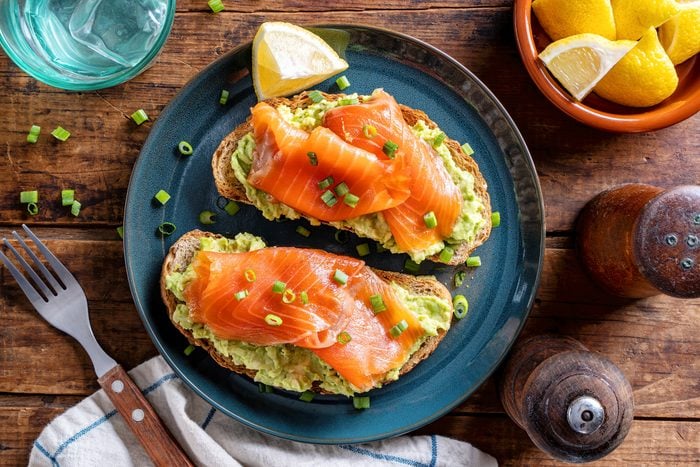Here’s How Much Fat You Really Need in a Day, with a Nutrition Expert’s Wisdom
Updated: May 11, 2023

You already know "healthy fats" like salmon and olive oil are better for you than steaks and cakes...but, in either case, nutrition authorities reveal how much fat we should all be eating each day.
Here’s the truth: Not all dietary fat is frowned upon. Although previous widespread opinion might have led you to believe that any food with fat would make you gain unhealthy weight…in reality, there are types of fat that can actually benefit your health. But how many grams of fat can you have—and should you have—per day?
According to registered dietitian Maggie Michalczyk, RDN, around 20% to 35% of your daily caloric intake should come from healthy fats. While this will vary slightly based on each individual’s caloric needs, for an average 2,000-calorie diet, your total fat intake would average around 44 to 78 grams per day.
To help further put this in perspective, the United States Department of Agriculture (USDA) explains: “Carbohydrates provide 4 calories per gram, protein provides 4 calories per gram, and fat provides 9 calories per gram.”
This means a well-balanced diet would see 400 to 700 calories a day coming from healthy fats.
Here’s what a “healthy fat” means
If 20% to 35% of your dietary intake should come from healthy fats, then, says Michalczyk, the healthy fats you should eat on the regular are “fish, dairy products, nuts, seeds, and oils. For example, olive oil, almonds, avocados, chia seeds, and salmon are all great sources of essential fats.” (Several of these are also on the list of the vitamin D-richest foods…so add them to your grocery list for some healthy double-duty!)
When nutrition experts refer to “healthy fats,” they typically mean sources of monounsaturated and polyunsaturated fats. Harvard University‘s public health website explains that of these types of unsaturated fats have been shown to reduce the risk of heart disease, improve blood cholesterol levels, ease inflammation, and more. These fats also include omega-3 fatty acids, a polyunsaturated fat typically found in foods like oily fish and seeds, which help cell function and support the cardiovascular and endocrine systems.
However, if you’ve glanced at a nutrition label, it’s possible you’ve noticed that saturated fat is also delineated as part of the total fat count. That’s because the Dietary Guidelines for Americans suggest that only 10% of your daily calories should come from saturated fat sources, while the American Heart Association actually recommends an even more conservative percentage of saturated fat taking up 7% of your daily calories. This is because saturated fat can raise LDL “bad” cholesterol and clog the arteries—so keep that butter, margarine, cheese, ice cream and other saturated fats to a disciplined minimum.
Another not-so-healthy type of fat is trans fat. Trans fat is an artificially made dietary fat that’s known to raise your LDL cholesterol, while simultaneously decreasing your HDL “good” cholesterol. This can cause your risk of heart disease to increase exponentially.
In 2015, the U.S. Food and Drug Administration (FDA) banned the use of trans fats in foods like commercial baked goods, margarine, and shortening. However, trans fat can still be found in foods that are deep-fried.
Eating These Foods Can Lead to Premature Death, Says New Study
Here’s what happens if you eat too little fat
Here’s an important insight: No matter the type of fat, if you eat too much of it, it’s likely you will gain weight.
However, if you’re not providing your body with enough dietary fat, then research shows your body won’t be able to absorb those essential fat-soluble vitamins like vitamins A, E, D, and K. Without these vitamins, your body may experience severe symptoms such as night blindness, osteomalacia (softening of the bones), increased oxidative stress, and haemorrhage (blood loss), among others.


















